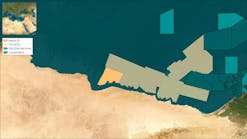John Waggoner • Houston
Petrobras pre-salt drilling advances ahead of new laws
Brazilian national oil company Petrobras has been authorized to begin drilling a new exploratory well in an area contiguous with its existing lease in the northern Santos basin, with an eye toward adding the acreage to its portfolio.
Under proposed new rules, Petrobras will become the operator of all new pre-salt licenses in Brazil. The bill is not yet approved. In exchange for the acreage, Petrobras will pay cash and pledge a share of production to the federal government.
The area to be drilled is contiguous with its Iara prospect in Santos, but outside the boundaries of the BM-S-11 block. Drilling is expected to reach a depth of 6,425 m (21,079 ft). The data and studies collected will be delivered to the government and become public at the end of the process, Petrobras says.
Brazil’s promising Tupi field is near the Iara prospect, and tests performed there are encouraging. Two formation tests on well 4-RJS-647 (4-BRSA-711-RJS) in the Tupi field both show high productivity of pre-salt carbonate reservoirs, according to Petrobras. The well flowed at an equipment-restricted rate of 5,500 b/d of light oil (approximately 32° API).
A larger, 100,000 b/d pilot test is scheduled to start-up in late 2010 or early 2011, and the company estimates initial production of up to 50,000 b/d of oil.
The Iara prospect, however, is not as well defined. While exploratory drilling outside the Iara acreage could shed more light on the prospect, extended well tests have not been performed on Iara fields. These are expected to begin by 2010, analysts say, and pilot tests similar to those planned for Tupi will follow.
Until those tests are performed, the real production potential of the northern Santos basin pre-salt areas remains a question of interpretation.
The motivation to allow Petrobras to drill outside its concession areas is to better understand the pre-salt acreage that will be transferred to the state owned company. While Petrobras may share risk with other companies, its capital stake would be defined at a minimum of 30%, and the national oil company would remain the operator of all new pre-salt projects. Petrobras’ partners would compete for these projects by pledging a portion of profit oil to the government.
Apart from general support in Congress, the measure is viewed as worrisome by independent producers who fear the laws will rebuild the Petrobras monopoly and discourage private investment.
Officials from Anadarko, which was the first independent to find pre-salt hydrocarbons in the Campos basin, say the company is waiting for Brazil’s new legislation before taking any decisions on expanding investment in pre-salt areas.
A compromise for small, independent producers appeared to be in the works with the suggestion that Petrobras desist from marginal oil fields (wells with less than 500 b/d production and reservoirs with under 1 MMbbl). These could be transferred to private third parties, who would be granted lower royalty rates as a temporary incentive. It is estimated that there are about 150 such marginal fields around Brazil.
At press time, the debate over the legislation remains in flux, with approval of the plan expected by the end of December.
Upstream costs may be bottoming out
The falling costs of building and operating upstream oil and gas facilities may be close to a reversal, according to IHS Cambridge Energy Research Associates (CERA).
“The IHS CERA upstream cost analyses show that some confidence has returned to the industry as oil prices have recovered and expectations rise for a strong economic recovery in 2010,” says Daniel Yergin, IHS CERA chairman.
The group found operating costs rose slightly and the descent of capital costs began to slow down in the past six months.
The IHS CERA Upstream Capital Costs Index (UCCI), which tracks costs associated with the construction of new oil and gas facilities, is down 4% over the past six months, although costs are near a bottom, the report finds.
The UCCI’s counterpart, the IHS CERA Upstream Operating Costs Index (UOCI), which measures operating costs for those facilities, rose by 1% in the past six months after falling 8% during the prior year.
Yergin cautions that “uncertainty related to present low oil demand and large spare capacity continues to hinder many projects.”
The indexes are tracked similar to the Consumer Price Index (CPI) and provide a benchmark for comparing costs around the world.
The reduction in capital costs was driven by sustained lower levels of upstream oil and gas activities, which resulted in a sharp decline in the costs of drilling rigs and yards and fabrication, the study finds.
Upstream steel costs continued to fall through 2009, dropping 12% from 1Q to 3Q 2009 on top of the 25.2% over the previous six months, but in the past quarter it now appears to have stabilized around the cost floor.
Purpose-built disposable motors for liner installation
Canadian technology firm The Motor Co. has developed a new line of “disposable” motors for one-time service in liner installation and completion.
The motor, when placed on the end of a liner string, allows the operator to drill or circulate the liner into place through tight spots and bridges, eliminating the need to trip casing and perform cleanout trips.
In the past, motors near the end of their service life were “sacrificed” for this application. The new disposable motor provides a purpose-built alternative with all new components and rigorous testing, aimed at improving reliability. According to the manufacturer, in testing the motors easily drilled in excess of 100 hours.
Disposable mud motors on the end of a liner string have been used successfully in Alberta to reach target depth. In offshore applications where day rates are high, the developers say the disposable motor may be a cost-effective alternative.






